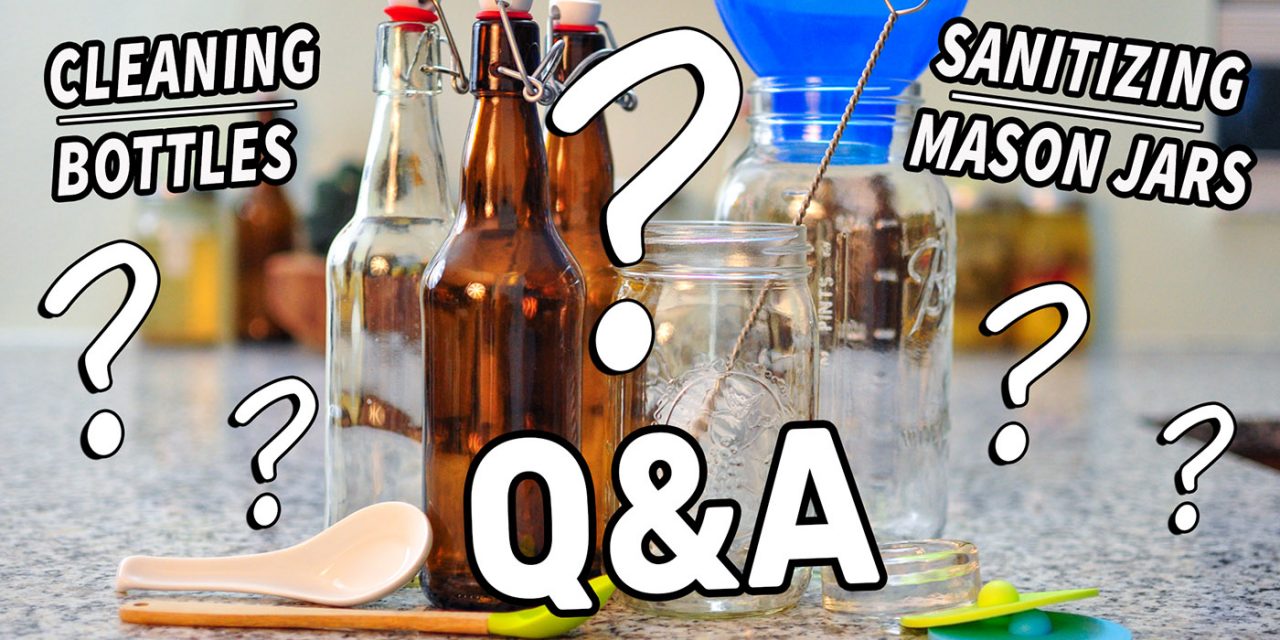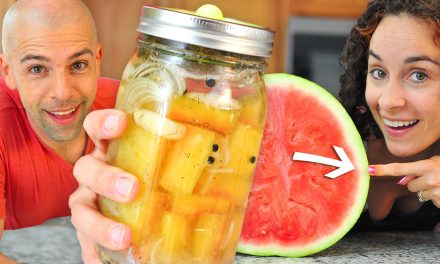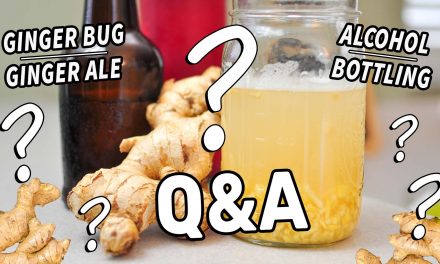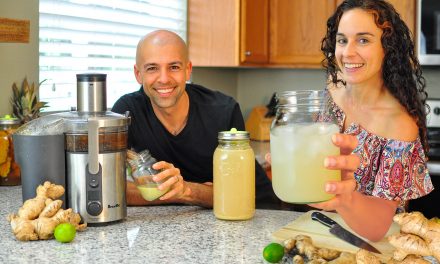We get a lot of questions about what could have gone wrong with your ferments, and one of the first things to consider is the cleanliness of your fermenting vessels! So today we’re diving into best practices and how we sanitize our mason jars and bottles.
Check out the full video and subscribe to our YouTube channel. We appreciate your support!
Sanitization vs Sterilization (Cleaning vs Disinfecting)
First what’s the difference between sanitization and sterilization? Both are valid options for fermentation and we use both in different situations.
METHOD 1: Sanitizing (Cleaning)
You can think of sanitizing as reducing the number of pathogens on a surface. Basically it’s what you’d think of as cleaning a surface to remove debris and pathogens by scrubbing and rinsing. You might even use soap to break up the debris to get it off of the surface.
METHOD 2: Sterilizing (Disinfecting)
Alternatively, you can think of sterilizing as killing everything on a surface using either chemicals or heat. It doesn’t mean you’ve removed the pathogens, only that they’re dead and shouldn’t pose a problem.
METHOD 3: USING BOTH (The Nuclear Option)
Our third method is using a combination of the two which is cleaning the surface to remove the number of pathogens and also killing off everything to make sure nothing survives. This is basically the nuclear option to ensure you won’t have problems with your ferments.
When do you need cleaning vs disinfecting?
It’s always important to clean your jars and bottles for healthy ferments, but it’s especially important if you’re using the same jar or bottle to make different types of ferments. You don’t want cross contamination! Unless you actually enjoy sourdough kombucha? Probably not.
General cleaning is always a good idea to make sure everything is clean, but disinfecting between use might be necessary to make sure there’s nothing left living in your container that will cross-contaminate the next batch.
Some indicators that your jars and bottles might need a thorough cleaning and sterilizing is when you’re having problems with your ferments. Perhaps you have slimy ferments, thick ferments, smelly ferments or you’re getting mold? If any of these sound familiar, then it’s time to do a little work and start with a clean fermentation vessel.
These same principles apply to jars, bottles, crocks, or any other fermentation vessel you might be using.
Sanitization Process & How to Clean Mason Jars & Beer Bottles
Step 1. Give it a rinse.
Give it a rinse using hot water. This will remove and loosen up the debris in the jar or bottle. You might only need to use this step if everything went well and you’re making the same ferment.
Step 2. Let it soak.
Add some soap to the bottles to help loosen up debris a little more. We like to use Dr. Bronner’s castile soap and let it sit with the hot soapy water for maybe an hour to help break up any particles.
Step 3. Wash and scrub it.
For debris that’s a little harder to get off, use a sponge or bottle brush to remove any extra sediment and give it a couple more good rinses.
Step 4. Let it dry.
Dry your container to store it without any moisture or it might get funky. It dries best upside down so that it can drain. Mason jars are easy to dry on a rack like this one that goes over your sink, but bottles are a little trickier. We love using this drying rack specifically made for beer bottles that works very well.
Step 5. Store it.
Store your containers in a dry place with the top on or upside down so nothing gets inside. For beer bottles, we close the top but don’t crank it down to save the seals.
Step 6. Before use, rinse it again.
Just in case there’s any residual dried chlorine or chemicals, we like to rise our containers with non-chlorinated water as an extra cleaning step before we ferment.
For most ferments, sanitization is probably good enough and has always worked for us. But if you’re having problems with your ferments, try going the extra step in the next section to sterilize your jars and bottles.
Sterilization Process & How to Disinfect Your Mason Jars & Beer Bottles
There are a handful of ways we use to sterilize our containers – using heat, chemicals, or a combination of both.
Sterilizing Jars & Bottles Using Heat
- Heat up a hot water kettle and pour boiling water into the bottles.
- Use a canning pot that has a rack for mason jars and boil the jars the same way home canners do to sterilize their jars.
- Use an Instant Pot that has a sterilize function. These are popular for sterilizing baby bottles.
- You can also heat up the jars and bottles using your oven the way some home brewers use. Be careful and check out home brewer forums on how to do this. Be careful to let it cool naturally back to room temperature before use and watch out! The jars and bottles are hot!
Sterilizing Jars & Bottles Using Chemicals
Running your containers through the dishwasher with detergent can sterilize your bottles well. Be sure to rinse afterward to make sure there’s no soap residue.
Using a sanitizing solution that beer brewers use can be an option after cleaning your container.
Top Cleaning & Sanitizing Tips for Healthy Ferments
1. Don’t forget to use the same sanitizing or sterilizing process for your other fermenting tools like spoons, funnels, and lids.
2. Use non-chlorinated water for final rinsing rinsing before use, for rinsing your fruit and veggies, and of course in your ferments.
3. Avoid cross-contamination by storing your ferments away from each other – like keeping the kombucha on the other side of the kitchen as the fermenting ginger ale.
4. It’s possible for bacteria to stick around on porous surfaces like wood, so if you’re using wooden utensils, you’ll want to either only use it for the same type of ferment or sterilize it after you’re done.
5. Keep your ferments out of direct harsh sunlight since that can be another sterilization method that will sterilize your entire bottle.
6. If you use a cloth cover for something like a ginger ale, only use it one time before washing it to decrease the likelihood of bad bacteria or cross-contamination.
7. Avoid using cheap metal utensils to stir your ferments because acids in ferments can break down the metal in low quality utensils and it could contaminate your ferment. Silicone, glass, or stainless steel are good options.
8. When making sodas, use your tester bottle only a limited number of times and only for the same type of ferment, again to avoid buildup of any bad bacteria or cross contamination.
>>> OUR FAVORITE FERMENTING GEAR <<<
Follow these steps and you’ll be on your way to healthy fermentation!
We hope all of these tips will help you in making the best ferments to enjoy. If you ever have any questions, feel free to leave them in the comments below or in the comments section on the video on YouTube!
Don’t forget to subscribe to our YouTube channel. Happy fermenting!








Greeting for both of you. keep going. I like your lovely channel so much. It has a lot of information about fermentation “The Fermentation Adventure” so lovely. The best you did the ferment without any addition. I would like you to present three things. When you can measure the alcohol content daily in “Tepache” during the fermentation and for all fermentation in the future. The second, when the drink is dangerous and I should not have it because, taste, smell or after period of time. The last, could you present the equal unite like 1 cup = … grams so on. Please, always keep smiling 😊
anyway I’m not good in English writing ☹
additional, does your fermentation for any fruits give a booze or hangover? someone said to me the white sugar give hangover so always use brown sugar!. Are there any difference between white, brown, fruits sugar during the fermentation and after?
Thank you so much for your kind words Osa! 😊 We’ll definitely keep going! That’s a great idea to make some kind of video or post on the alcohol content in tepache. We make it a lot so that would be fun to know. We’ll look into what that would be in grams. When you see your drink has fermented with bubbles and there’s no mold and doesn’t smell bad, then you should be good to taste it. You would probably know right away on the taste too. We always use raw sugar in our drinks which is still basically white sugar and in tepache we use white sugar and also molasses. We haven’t had hangovers from the drinks because we only enjoy a small glass of them, but let us know if you do! Haha. Good luck and thank you so much again!